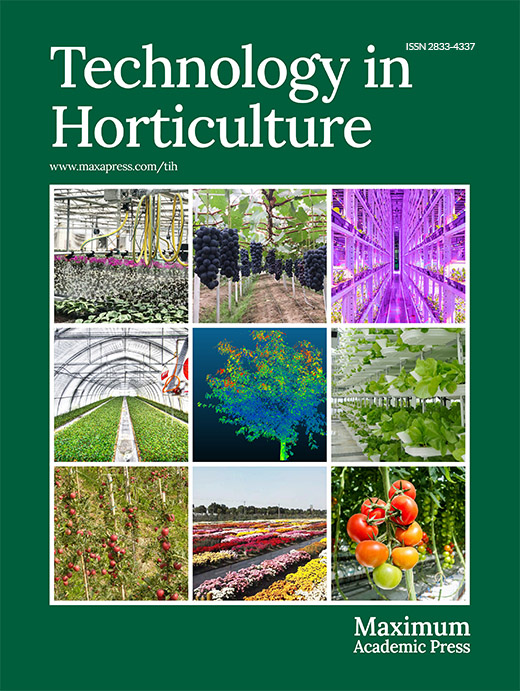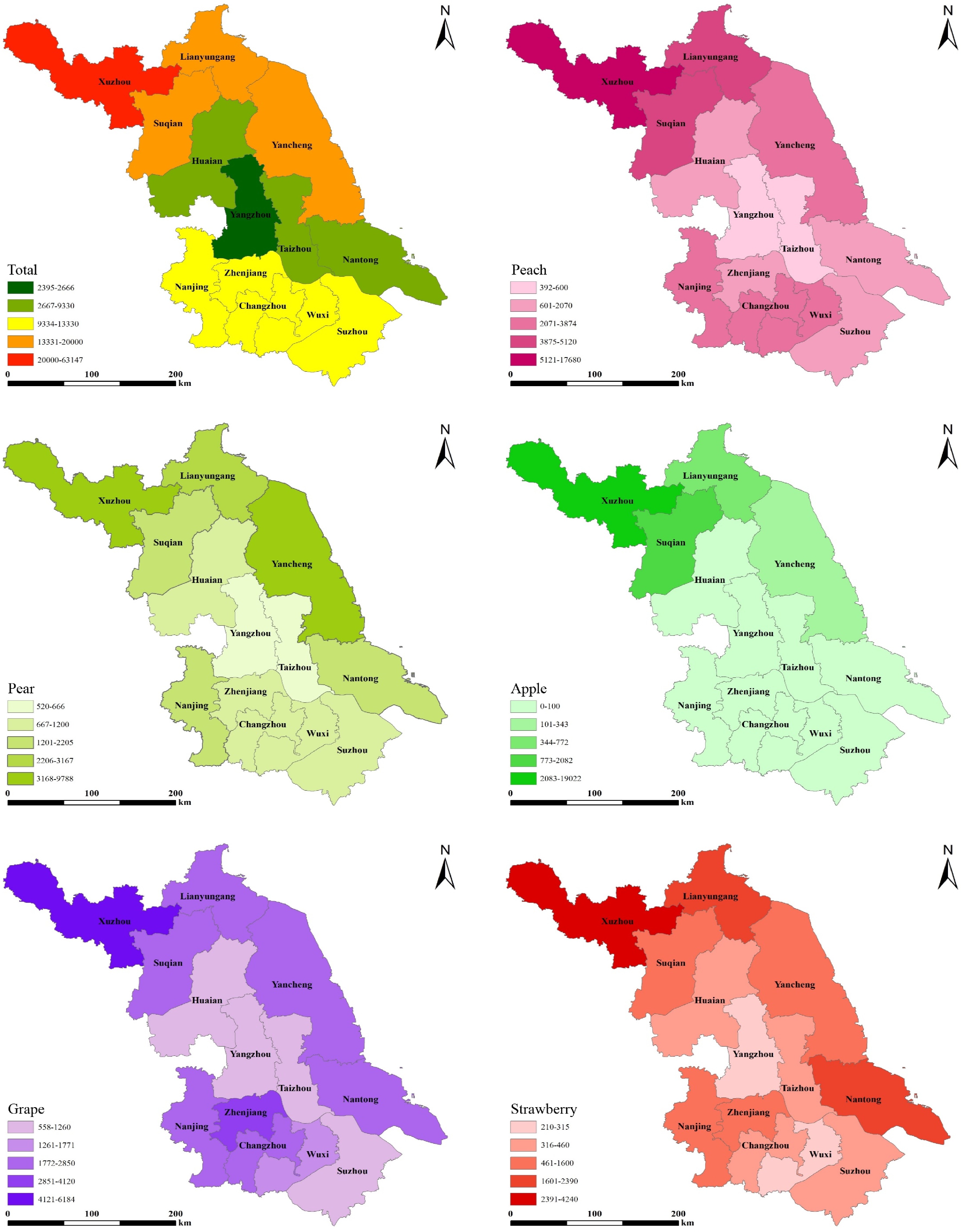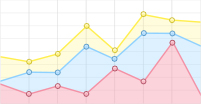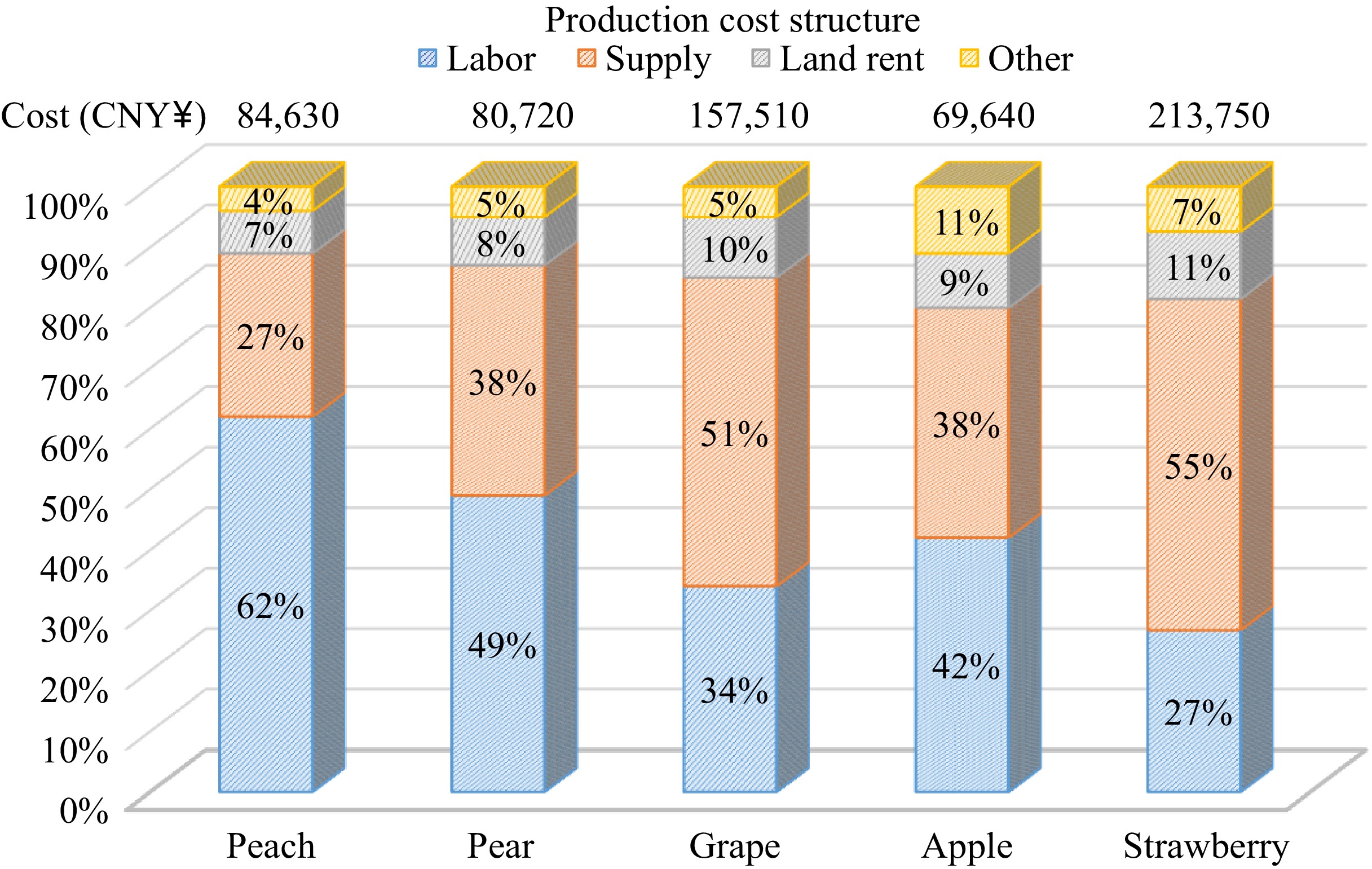-
Jiangsu Province, situated in the eastern part of China, spans 30°45' to 35°08' north latitude and 116°21' to 121°56' east longitude, is strategically positioned in the lower reaches of the Yangtze River and Huaihe River. Bordered by the Yellow Sea to the east, it neighbors Shanghai and Zhejiang to the southeast, Anhui to the west, and Shandong to the north[1]. The province experiences a diverse climate, marked by regional variations, encompassing a transition zone from China's subtropical to warm climate. Jiangsu boasts a rich array of deciduous and evergreen fruit tree species and varieties, capitalizing on its climatic diversity. Furthermore, the Fruit Tree Industry in Jiangsu Province benefits from advantageous conditions such as convenient transportation, robust financial support, a high-end consumer market, and a solid foundation in agricultural policies and scientific technology[2]. As China undergoes economic and social development, coupled with rising living standards, consumers exhibit a growing preference for high-quality, safe, and environmentally friendly fruits, meeting this demand aligns with the strategy of advancing efficient agriculture in Jiangsu[3]. Actively developing the fruit tree industry not only contributes to this agricultural strategy but also effectively enhances the economic well-being of farmers, emerging as a pivotal choice for the evolution of efficient agriculture.
The evolving landscape of the fruit market, coupled with intensified competition, poses numerous challenges for the development of the fruit tree industry in Jiangsu Province. A comprehensive analysis of the current state of the industry reveals significant gaps in specialized production, modern facilities, the application of new technologies, and fruit safety production when compared to industry standards[4]. These limitations present notable constraints and pressing issues that require immediate attention and resolution. Moreover, the industry faces strong competition originating from neighboring provinces such as Anhui and Shandong. The year 2021 witnessed the introduction of the 'Regulations on the Implementation of the Land Administration Law of the People's Republic of China' which is the most stringent to date. The arable land protection system emphasizing 'non-agriculturalization and non-grainization', along with the concept of 'fruit trees on the hill or slope' proposed at the 2023 Central Rural Work Conference, signifies a substantial challenge for Jiangsu's fruit industry[5]. These regulations impose a considerable squeeze on the fruit industry, demanding a strategic response to navigate the stringent landscape. The overarching concept of 'fruit trees on the hill or slope' as outlined in the 2023 Central Rural Work Conference, indicates a paradigm shift for the fruit tree industry[6]. These transformative changes mean that Jiangsu's fruit trees industry are confronted with the pivotal question of how to navigate and sustain development.
To gain a profound insight into the current state of the fruit industry in Jiangsu Province, the Jiangsu Provincial Academy of Agricultural Sciences, under the leadership of the fruit tree sector, collaborated with scientific research units and municipal extension units across the province. A systematic research initiative was undertaken to assess the current status and technology demands within the fruit tree industry. The primary objective of this research is to offer valuable insights that can serve as a reference for steering the high-quality development of the fruit tree industry.
-
To comprehensively assess the current status and challenges in the development of the fruit tree industry in Jiangsu Province, and to provide informed decision-making support for the scientific advancement of the industry, the Jiangsu Academy of Agricultural Sciences led research activities on the current state and technical requirements of the fruit tree industry. The study focused on the primary fruit tree production areas in Jiangsu Province, including seven cities (Xuzhou City, Lianyungang City, Suqian City, Wuxi City, Suzhou City, Zhenjiang City, Nanjing City). Simultaneously, sporadic fruit tree planting in six additional cities (Yancheng City, Huai'an City, Yangzhou City, Nantong City, Taizhou City, Changzhou City) were also covered. The main emphasis of the research was on the existing issues, technological needs, and product sales in the key fruit tree production areas in Jiangsu Province.
Research targets and methods
-
The primary targets of this research encompass provincial agricultural authorities, local government departments, grassroots agricultural extension workers, emerging agricultural enterprises, large-scale planting households, and experts specializing in relevant fruit tree species.
The research employs a multifaceted approach, combining field research, seminars, and exchanges, questionnaires, collection of industry reports, expert forums, and other methodologies.
Content and theme of the research
-
The main contents of the research include fruit tree main promoted varieties, main promoted technology, planting mode, etc.; outstanding demand for varieties and technology; key technical problems in production; orchard production scale, marketing mode, sales mode, labor input, the use of agricultural machinery, economic benefits, etc.
-
The research findings indicate that the fruit cultivation area in the province covers 197,456.2 hm2, the total production is 3.8 million tons, contributing to a primary production output value of approximately CNY¥38 billion. The predominant cultivated fruit trees and their corresponding areas are as follows: peach: 48,492.5 hm2, pear: 32,022.1 hm2, grape: 31,163.3 hm2, apple: 22,335.1 hm2, strawberry: 16,244.6 hm2 (Table 1). Furthermore, there are other fruit trees, including loquat (Eriobotrya japonica), waxberry (Morella rubra), blueberry (Vaccinium spp), citrus (Citrus reticulate), persimmon (Diospyros kaki), kiwi (Actinidia chinensis), etc., with significant planting areas. Notably, loquat and waxberry have larger cultivation areas, measuring 4,036.2 hm2 and 3,464.5 hm2, respectively. Fruits such as blackberry (Rubus fruticosus), green plum (Vatica mangachapoi), cherry (Prunus pseudocerasus), and pomegranate (Punica granatum) exhibit modest development, with areas falling below 1,100 hm2. Dry fruits like chestnut (Castanea mollissima), ginkgo (Ginkgo biloba), and thinshelled walnut (Carya illinoinensis) have also gained traction, with respective development areas of 8,884.5, 7,168.2 and 6,266.7 hm2[7].
Table 1. Primary cultivation areas and production centers of key fruit trees.
Tree species Area (hm2) Yield (ton) Main production area Peach 48,492.5 973,660.7 Xuzhou, Suqian, Wuxi,
Zhenjiang, Yancheng, NanjingPear 32,022.1 775,309.2 Xuzhou, Yancheng,
Lianyungang, Nantong,
Nanjing, SuqianGrape 31,163.3 653,021.9 Xuzhou, Zhenjiang,
Changzhou, Lianyungang,
YanchengApple 22,335.1 571,645.8 Xuzhou, Suqian,
LianyungangStrawberry 16,244.6 529,754.2 Nantong, Xuzhou,
Nanjing, Suqian,
Yancheng, ZhenjiangOther 47,198.7 299,187.1 Nanjing, Yangzhou, Suzhou, Changzhou, Wuxi, Nantong Total 197,456.2 3,802,578.9 The planting layout of fruit trees in Jiangsu Province is characterized by regionalization, with distinctive features evident across various zones, the total distribution of fruit trees and major fruit trees in each city can be seen in Fig. 1. Presently, the province boasts several strategically advantageous fruit tree production areas, each contributing unique characteristics. These key regions are delineated as follows. (1) Yellow River Road Fruit Tree Production Area (Xuzhou, Suqian, Lianyungang): This area claims the largest fruit tree production region, covering approximately 10,000 hm2. Cultivation includes staple Jiangsu fruit trees such as apples, pears, and peaches. Prominent examples like Fengxian Dashahe apples and Siyang fresh peaches underscore the region's robust brand advantage. (2) Ning Zhen Yang Hilly and Mountainous Fruit Tree Production Area (Zhenjiang, Nanjing, Yangzhou): Similar to the previous zone but encompassing a broader range of tree species, including peaches, pears, grapes, and strawberries. This has resulted in the establishment of characteristic brands such as White Rabbit strawberryies and Dingzhuang grapes, contributing to the region's distinct identity. (3) Evergreen Fruit Tree Production Area Around Taihu Lake (Suzhou, Wuxi): Primarily concentrated in Suzhou and Wuxi, this region focuses on evergreen fruit trees like citrus, loquat, and waxberry. Notable brands such as Xishan Waxberry and Dongshan Loquat have emerged, reinforcing the region's characteristic identity. (4) Suzhong Sporadic Fruit Tree Planting Area: Encompassing various locations, including Yandu, Hai'an, and Rugao, this region is characterized by diverse and unique fruit varieties. Examples include Yandu's pears, Hai'an's small square persimmons, and Rugao's purple peaches adding distinctive features to the area[8].
Moreover, cities such as Nanjing, Yangzhou, Suzhou, and Wuxi boast expansive consumer markets. These urban centers have cultivated a local planting circle focusing on distinctive fruit trees such as strawberries, blueberries, kiwis, and cherry peaches. Although the scale of cultivation in these inter-city planting circles may not be extensive, but the economic returns are substantial, showcasing significant growth potential.
Overview of fruit tree production and development in Jiangsu Province
-
Jiangsu Province has a long history of fruit tree cultivation, with a large area already cultivated in the 1920s. In the 1960s and 1990s, it entered a period of rapid development, and stable development began in the 2020s, with an area of about 200,000 hm2. In recent years, the fruit tree industry in Jiangsu Province has witnessed rapid growth, marked by an increasing diversity of fruit tree types, optimization of variety structures, and expansion of cultivation areas. Consequently, the province has established distinct regional characteristics within the fruit industry[9]. However, the cultivated area of fruit trees in Jiangsu is approximately 197,456.2 hm2, yielding around 3.8 million tonnes of output. Despite these figures, the province ranks only 25th in the nation in terms of fruit production. Considering that Jiangsu is the fourth most populous province in the country, its reliance on fruits from other provinces remains notably high. The topography of Jiangsu is predominantly plain (86.89%), covering an area of 8,970,600 hm2, with mountains occupying 160,700 hm2 (1.50%) and hills spanning 1,191,613 hm2 (11.11%)[10]. In accordance with the latest policy directives, development potential is limited to hilly and mountainous areas, as well as the Yellow River course. However, challenges persist in these areas, such as sticky and acidified soils in hilly and mountainous regions and saline, sandy soils in old road beach locations. Consequently, the prevalence of low-yield and low-efficiency orchards in these areas diminish the enthusiasm for fruit tree development to a certain extent.
Contemporary cultivation techniques and their applications
-
In the realm of fruit tree production, the advancement of three-dimensional planting, integrated management of fertilization and irrigation, meticulous flower and fruit management, adoption of cutting-edge pest and disease control methodologies, and the implementation of eco-friendly prevention measures collectively serve to significantly elevate fruit quality. This strategic approach not only enhances market competitiveness but also contributes to the overall improvement of fruit quality and planting profitability[11,12].
Cultivation models
-
Peaches, pears, and apples are predominantly cultivated in open fields, with some utilizing facility cultivation[13]. In newly established peach orchards, a V-type structure is predominantly employed, emphasizing a main branch with a jubilant configuration. In pear tree orchards, the newer cultivation practices often involve trunk-oriented and Y-type structures, while apples lean towards a more trunk-centric shape. Notably, strawberry cultivation primarily occurs in greenhouses, characterized by their light, straightforward, and efficient attributes. Rain-sheltered cultivation techniques for grapes have successfully overcome the natural constraints that hinder open-field grape cultivation south of the Yangtze River. This advancement has significantly propelled grape cultivation in the province, now constituting over 85% of the total grape cultivation.
Kiwi is primarily cultivated in open fields, with a limited number of instances employing rain-sheltered or shade cultivation. Blueberry, waxberry, cherry, and peach, on the other hand, exhibit improved fruiting characteristics when cultivated in facility settings. Notably, rain-sheltered cultivation for waxberry has been successfully tested and promoted to counter the adverse effects of rainy weather. For citrus and dragon fruit, thermal insulation facilities are essential for cultivation. Plant spacing is adjusted based on facility conditions, generally ranging from 2 m by 3−4 m. In the Suzhou region, waxberry and loquat cultivation often involve intercropping with tea, and orchards feature multi-species mixed planting. This approach is designed to increase orchard output per unit area and mitigate the impact of annual variations in the orchard yield, thereby stabilizing annual income.
Green prevention and control technology
-
Adhering to the 'prevention first, comprehensive control' principle, orchard pest management primarily relies on agricultural, physical, and chemical control methods[14]. Notably, certain green prevention and control products, including insecticide lamps, yellow boards, and fruit bags, have demonstrated relatively high application rates, which play a great role in promoting the control of diseases and pests and improving the safety of fruits. The adoption of biological control measures, such as the use of predatory mites to combat pear small heartworm and psyllids, is steadily increasing. While agricultural and physical controls play significant roles, chemical control remains a primary approach for pest prevention, with an application rate ranging between 65% and 90%[15]. Research and development efforts in the realm of efficient and low-toxicity pesticides, as well as biological control pharmaceuticals, continue to advance, contributing to the evolution of green pest management practices.
Soil, fertilizer, and water management
-
Most orchards utilize natural grass or ground cloth cover as part of their management strategy, while some opt for artificial grass, typically selecting varieties such as hairy leaf camas, ryegrass, and alfalfa[16]. In orchard management, a common practice involves the application of commercial organic fertilizers in conjunction with chemical fertilizers. Some orchards in central Jiangsu adopt a combined planting and breeding model, using biogas slurry as fertilizer in pear orchards, such as the Taixing pear-pig manure-biogas cycle and the Suzhou Xishan loquat-lake-sheep planting and raising cycle. However, it is noteworthy that many fruit growers have yet to adopt the concept of balanced fertilization. The understanding of soil nutrient status and tree fertilizer requirements remains unclear, leading to the excessive use of chemical fertilizers without due attention to soil improvement. Consequently, this has resulted in low organic matter content, poor physicochemical properties of the soil, and adverse effects on the growth, development, and fruit quality of the fruit trees. In addition, some orchards do not pay enough attention to water management. Irrigation and drainage facilities still need to be further enhanced.
Orchard mechanized management
-
The cultivation system has undergone improvements, with labor-saving and machine-friendly friendly training systems gradually replacing traditional approaches[17]. For instance, cultivation techniques like the open-center shape with two main branches for peaches, the main stem shape for pears, and elevated cultivation for strawberries have been successfully utilized for advancing orchard mechanization. Agricultural equipment, including air-fed orchard spraying machines and furrowing machines have been introduced, leading to a substantial increase in production efficiency. The covered area of various orchard machinery ranges from 600 to 7,500 hm2, indicating how large an orchard can be met by a single type of machinery. Currently, orchards have achieved mechanization in operations such as plant protection, fertilization, and weeding; the application of mechanization in orchards can be seen in Table 2. However, in older orchards, factors such as narrow-row spacing impedes the entry of medium and large agricultural machinery, limiting operations to small machinery and consequently reducing operational efficiency. Presently, the degree of orchard mechanization in the province remains relatively low, at approximately 35%, indicating a gap in both the application ratio and research and development strength compared to developed countries such as European countries and the United States[18].
Table 2. Application of orchard mechanization.
Type of machinery Price (CNY¥) Area covered (hm2) Application ratio Note Ditching and fertilizing machine 6,000−40,000 3,750 68.6% Small fertilizer tanks, frequent loading, not suitable for mountainous areas Plant protection sprayer 1,600−15,000 1,500 86.9% Wide variation across orchards Grass cutter 3,000−50,000 2,250 90.8% Mainframe suitable for orchard with large row spacing and low application probability Rotary tiller 4,000−20,000 3,450 69.4% Only suitable for larger spacing, destroys shallow roots Trenching machine 3,000−7,000 3,450 72.4% Higher use of new parks and fertilizers Unmanned spraying machine 3,000−10,000 2,250 87.5% Most tree forms are unsuitable Tractor 25,000−50,000 1,500 15.3% Most models are too large Tracked transporter 10,000−35,000 600 90.6% Higher garden requirements Ditching and fertilizing machine 50,000−9,000 750 90.2% Most models are too large Ridge maker 1,500−4,000 7,500 20.3% Mostly used for gardening, mostly not procured Branch and twig grinder 1,000−4,000 4,500 6.2% More applications in peach, pear Water and fertilizer integrated system 20,000−50,000 5,250 30.8% Most orchard are not equipped Benefits and costs of cultivating key fruit trees in Jiangsu Province
-
Due to neighboring the high-end markets in Zhejiang, and Shanghai, the efficiency of fruit tree cultivation in Jiangsu ranks among the top in the nation. Notably, fruits such as strawberries, loquats, and sweet cherries command higher sales prices (Table 3). The ex-farm prices often exceed CNY¥10 per kilogram or more. However, it is crucial to recognize that the apparent high profitability is counterbalanced by equally high production costs.
Table 3. Production and price of major fruit trees.
Type Yield per kg/hm2 Price out of the garden (CNY¥/kg) Peach 22,500−67,500 5−24 Pear 45,000−112,500 3−24 Strawberry 37,500−82,500 12−70 Apple 33,000−52,500 3−8 Grape 33,000−52,500 8−24 Loquat 9,000−12,000 24−48 Waxberry 6,000−13,500 16−28 Sweet cherry 18,000−28,500 28−44 Blueberry 15,000−22,500 14−30 Kiwi 12,000−27,000 12−24 In the cultivation of peaches, pears, and apples, the associated costs range from CNY¥45,000 to CNY¥80,000 per hm2. Within this expenditure, labor costs constitute approximately 49%−60%, orchard materials account for 27%−38%, and land rent falls within the range of 7%−9% ( Fig. 2). For grapes and strawberrys, the overall cost ranges from approximately CNY¥150,000 to CNY¥230,000 per hm2. Labor costs contribute to about 27%−34%, while material and service costs comprise 51%−62%. Park management costs and material inputs in southern Jiangsu surpass those in the northern part of the region, leading to higher economic benefits in southern Jiangsu compared to its northern counterpart.
The overarching expenses in orchard cultivation primarily revolve around labor management, agricultural expenditures, and land rent (Table 4). Labor costs represent approximately 45% of the total expenses, notably increasing each year due to substantial labor inputs in activities such as pollination, bagging, shaping, pruning, harvesting, and other essential tasks. Conversely, land rent remains relatively consistent across every year.
Table 4. Orchard cost expenditures.
Managerial labour (person/hm2) Average wage of employees (¥/day) Agricultural expenditure (¥/hm2) Fertilization 30 Pruning 45 Permanent workers 80−200 Pesticides 15,000−30,000 Pesticide application 30 Weeding 30 Temporary/seasonal workers Men: 100−200; women: 80−120 Fertilizers 37,500−90,000 Thinning fruit 45 Harvesting 45−75 Other 120−300 Irrigation facilities 1,500−3,000 Bagging 45 Other 45 Other 18,000−45,000 Analysis of fruit marketing models in Jiangsu Province
-
Following harvest, fruits in Jiangsu Province, especially peaches, pears, and apples undergo wholesale and retail sales. In the northern part of Jiangsu, where fruit production is higher, a greater proportion is directed towards acquisition or wholesale markets, with relatively less emphasis on tourism and leisure farmers' picking activities. Conversely, in the southern region of Jiangsu, where fruit quality tends to be higher, the predominant marketing channels involve wholesale transactions, picking, or sales in the form of gift boxes. For instance, in the Nantong area, approximately 30% of fruit sales occur through picking or retail, around 20% enter local fruit shops, approximately 35% are wholesaled to major cities such as Beijing, Shanghai, and Nanjing, with about 5% involving large truck wholesale at the doorstep. Additionally, approximately 10% of the fruit is sold through e-commerce platforms. Based on statistical data, the sales distribution between online and offline channels stand at an approximate ratio of 1:3.
Integrated development of primary, secondary, and tertiary industries
-
In the context of Jiangsu's extensive agricultural landscape, facility agriculture, and agro-tourism, the cultivation of fruit trees has emerged as a preferred initiative for advancing efficient agriculture in numerous regions. The fruit tree industry has been a catalyst for the rapid growth of rural tourism. Various activities, such as peach flower festivals, pear flower festivals, strawberry festivals, and farmers' harvest festivals, have been organized to integrate culture and tourism, facilitating the swift development of tertiary industries and significantly boosting local tourism[19]. For instance, Dafeng Hengbei Village in Yancheng City strategically leverages the advantages of the fruit tree planting industry. Focused on the theme of 'pear orchard scenery, ecological livability, and rural tourism', the village harnesses the cultural appeal of pear orchards, actively promotes rural tourism, and exemplifies an integrated development model across primary, secondary, and tertiary industries. Similarly, Tianlai Village Ecological Theme Manor in Haimen District, Nantong City, received the prestigious title of 'the oldest local garden in China' from the Guinness Book of World Records in 2015. This establishment serves as a diversified and ecological agricultural integrating activities such as fruit picking, sales, lodging, and hot springs. It stands as a noteworthy exemplar of the integrated development of the local industry in the Nantong area.
-
The planting area of fruit trees in Jiangsu approximately 197,456.2 hm2, yielding a production of around 3.8 million tonnes. However, Jiangsu's population ranks 4th in the country, indicating that Jiangsu exhibits a high reliance on imported fruits[20]. The majority of business entities in Jiangsu maintain orchard sizes ranging from 300 to 1,500 hm2, predominantly adhering to individual or family-based planting models. This prevailing pattern lacks the formation of industrial clusters characterized by substantial scale and influence. Despite the presence of numerous high-quality brand fruits, the overall output remains insufficient to meet the province's internal demand. Consequently, the competitiveness of Jiangsu's fruit production in the national market is currently below the desired level.
The fruit tree industry in Jiangsu Province suffers from a lack of a well-structured regional development layout, leading to uncoordinated and repetitive development at a lower level. Numerous fruit tree planting and management entities have pursued geographical and individual differentiation without adequately considering the characteristics of tree species[21]. This has resulted in the improper selection of varieties, leading to increased risks. For instance, in northern Jiangsu, blueberries are cultivated in salinized areas, and Loquat is grown in facilities, while in southern Jiangsu, efforts are ongoing to cultivate sweet cherries. Moreover, the prevalence of regional and seasonal surpluses has become a recurring issue. For instance, during the period from June to August, there is a concentration of mature peaches, pears, and apples in the Xuzhou region, resulting in a stagnation of fruit and a subsequent decline in prices. Simultaneously, the southern region faces a shortage of these fruits during the same period.
Absence of comprehensive variety planning and noticeable market concentration
-
The selection of fruit tree cultivars should ideally align with regional soil and climate conditions, among other factors[8]. Variety selection necessitates a consideration of the region's climate, production conditions, and various other comprehensive factors. Presently, the majority of fruit tree cultivation lacks a well-structured variety planning strategy. Production tends to heavily favor late-maturing varieties, leading to a concentrated maturity period, increased sales pressure, and subsequently lower selling prices. Furthermore, there is a tendency to blindly follow trends in planting, resulting in a prevalence of single-variety cultivation. For instance, the grape variety 'Shine Muscat', known for its distinctive color and aroma, experienced rapid development in Jiangsu Province, leading to its widespread adoption in major markets and subsequently causing a significant decline in its market price. Therefore, it is imperative to adopt a more diversified approach in selecting varieties for cultivation, fostering a richer variety structure that aligns with the diverse consumer demand for fruits.
Inadequate integration of agro-mechanical practices and agronomy, leading to high labor costs
-
The synergy between agricultural machinery and agronomic practices is lacking, and there is a disconnect between orchard management and machinery utilization[22]. In the construction of orchards, most fruit trees are not designed with due consideration for mechanical equipment and facilities. Consequently, orchard construction standards are lower, and row spacing in the fields is narrower, constraining the implementation of mechanical operations in orchards. This is particularly evident in critical tasks such as fruit thinning, bagging, harvesting, and pruning, where the labor-intensive nature and time constraints pose challenges to the overall mechanization of the fruit industry. Additionally, factors such as mechanical operation limitations, maintenance issues, and product prices contribute to the current sub-optimal level of mechanization in fruit tree production in Jiangsu Province.
The issue of an aging workforce in fruit tree production is progressively worsening, with a majority of orchard laborers falling within the age range of 53 to 75 years. Due to age-related constraints, the adoption of new varieties, technologies, and cultivation methods are limited. This deficiency results in consistently high orchard production costs, thereby impeding the advancement of fruit production in the region. The escalating orchard production costs, exemplified by pear cultivation, underscore the challenges faced. For instance, the fertilizer costs for 1 hm2 of land amount to CNY¥22,500, while labor and machine operation expenses can soar as high as CNY¥30,000. Notably, orchard material and service costs account for a substantial 57% of the overall production costs. In the case of one hm2 of peach cultivation under traditional methods, an average of 520 workers is employed throughout the year. The costs of labor for managing 1 hm2 range from CNY¥45,000 to CNY¥75,000, and agricultural materials contribute an additional CNY¥52,000 to CNY¥80,000. The shortage of labor further exacerbates the situation, resulting in labor and material costs comprising over 60% of the input ratio.
Inadequate standardization in orchard construction and outdated fruit tree facilities
-
The predominant cultivation mode in orchard production in Jiangsu Province adheres to traditional practices, lacking standardized construction. Non-standardized planting row spacing is a prevalent issue, resulting in narrow spacing and inter-row depression as the trees grow. This condition adversely impacts ventilation and light transmission, leading to an increased incidence of pests and diseases and a decrease in fruit quality. Moreover, there is a pressing need for upgrading orchard facilities in terms of coverage and quality. Numerous orchards suffer from sub-optimal conditions in terms of old roads, ditches, supporting rooms, and other infrastructure. Furthermore, a significant portion of orchards lack the capacity to invest in essential equipment such as cold storage for fruit preservation. An illustrative example is the promotion of the early cultivation of peach trees in the northern region, where the greenhouse film, often aged and with poor light transmission, not only fails to achieve the intended purpose of promoting early maturity but also significantly compromises the quality of peach fruit.
Deficiency in green safety practices
-
The adoption of green and safe production concepts in orchard production still requires significant enhancement[23]. Notably, there are challenges in the standardized use of medications and proper application of fertilizers, leading to environmental concerns. (1) The ecological condition of orchards is sub-optimal. Survey findings indicate that peaches and pears are subjected to medication approximately 7−10 times throughout the year, with some late-maturing varieties receiving up to 12 treatments. In certain production areas, the use of herbicides exceeds the annual usage of chemical pesticides, reaching up to 1/3 of the total. (2) Soil background conditions are less favorable, especially in regions near the Yellow River and hilly hillock slopes, where the soil's organic matter content hovers around 1%. This necessitates the extensive use of chemical fertilizers, contributing to soil acidification and slatting phenomena due to improper fertilizer application. (3) There is a lack of precision in chemical control practices. In some orchards, the quantity and frequency of pesticide use surpass 30% of the recommended standards. Instances of pesticide application just before fruit harvesting are not uncommon, posing challenges in ensuring the safety of fruit products. (4) Orchard inputs vary in quality, and highly toxic pesticides remain accessible through 'special channels', indicating a need for stricter regulation and control measures.
Deficiency in plantlet breeding bases and unregulated plantlet promotion
-
Jiangsu Province faces a notable gap in the establishment of well-equipped plantlet breeding bases, resulting in challenges related to the quality and quantity of nursery plantlets. This inadequacy necessitates the annual procurement of a substantial number of peach, pear, and strawberry plantlets from other provinces, hampering the autonomous development of the modern fruit industry. Given that most fruit tree plantlets can be acquired through asexual reproduction, safeguarding the rights to fruit tree varieties has emerged as a complex issue. The fruit tree plantlet market has been in an unregulated state for a long time, with plantlets lacking conformity certificates, production licenses, and business licenses entering the market without restraint. The market is inundated with counterfeit and uncertified plantlets, often leading to confusion regarding varieties and instances where the same product is sold under different names. Driven by profit motives, some plantlet dealers engage in speculative practices, promoting varieties unsuitable for cultivation, this has resulted in significant financial losses for growers.
Limited variety and proportion of processed products, insufficient industrial chain derivation
-
In Jiangsu Province, the post-harvest scenario predominantly involves fresh fruit, with a significant portion lacking processing into value-added products. The existing cold storage infrastructure is insufficient to meet the market demand for extensive fruit storage[24]. Outdated storage and processing equipment, coupled with inadequate storage technology, contribute to the prevalence of storage-related issues, leading to serious late-stage diseases in some fruits, such as rot disease in peaches and tiger skin disease in pears. According to available statistics, the province's fruit storage capacity is 432,000 tonnes, with cold storage accounting for only 172,000 tonnes and gas-conditioned storage at 13,000 tonnes. This represents a mere 10% of the total fruit production in the province. Furthermore, the fruit processing capacity is 216,000 tonnes, reflecting a processing industry that is not sizable, often equipped with aging machinery, resulting in sub-optimal processing quality and low utilization rates. In terms of commercialization, the packaging is often simplistic, and there is a lack of strict fruit grading, leading to a low level of commercialization and reduced economic efficiency in the sector[25].
-
There is a critical need to intensify the exploration of fruit tree germplasm resources, with a particular emphasis on precisely identifying and leveraging specific traits within local variety resources and wild resources[26]. It is recommended to establish a resource protection nursery and promptly initiate the collection, preservation, and evaluation of these resources. Simultaneously, efforts should be directed toward the assessment and utilization of valuable resource traits and genes, aiming to cultivate more new varieties that are well-suited to the local climatic conditions.
Excellent varieties form the foundation for the sustainable development of the fruit industry[27]. Currently, the primary focus of variety selection and breeding in Jiangsu Province's fruit tree industry revolves around attributes such as high quality, early maturity, disease resistance, and resilience during storage and transportation. Additionally, there is a prominent emphasis on developing labor-saving varieties, characterized by traits like low flower density and medium tree potential, marking a significant direction in innovative variety development. Simultaneously, it is crucial to consider the diverse requirements of different consumer groups, including factors such as quality, nutrition, functionality, and appearance[28]. As the standard of living continues to rise, the demand for fruit products among the populace reflects increasingly diversified, multi-level, and multi-faceted characteristics.
Optimizing the industrial layout and facilitating the dissemination of superior varieties
-
Jiangsu boasts a robust agricultural scientific research force, and its independent cultivation of high-quality fruit tree varieties, which makes Jiangsu leading in the domestic market. To capitalize on this strength, it is imperative to continue enhancing the layout of fine varieties with independent intellectual property rights in Jiangsu, promoting their breeding and dissemination[29]. Simultaneously, there should be an active initiative to introduce high-quality varieties from both domestic and international sources to meet the diverse demands[30]. Recognizing that the Fruit Tree Industry in Jiangsu Province should not adopt a singular large-scale planting approach akin to the 'apple mode', the following recommendations are proposed: (1) Leveraging the distinctive characteristics of the transitional zone between the northern and southern production areas in Jiangsu, precise positioning of different maturity varieties should be undertaken in various planting areas. This approach aims to achieve staggered harvests, effectively regulating market supply. (2) Implementing precise positioning of different maturity varieties in each production area layout to ensure a uniform distribution of varieties at varying stages of maturity, thereby alleviating the pressure associated with concentrated fruit maturation.
Advancement of orchard mechanization and reduction of orchard management costs
-
Currently, there is a growing demand for mechanization in fruit tree production, with an increasing emphasis on simplification. Agricultural mechanization stands as a pivotal trend for future development[31]. Given that the majority of orchards in Jiangsu have an area between 300−1,500 hm2, it is imperative to align with regional agricultural characteristics and production needs. Therefore, there should be accelerated research and development efforts aimed at creating efficient and practical agricultural machinery. This involves the creation of practical, labor-saving small-scale machinery capable of seamlessly integrating into the entire production chain. Promoting orchard mechanized production models through various means is essential. This approach aims to garner recognition among technicians and fruit tree production practitioners regarding the labor-saving, quality-enhancing effects of mechanized production. Accelerating the widespread adoption of mechanization in production is a crucial step forward for the modern fruit tree industry.
Enhancement of research and development in standardized cultivation techniques and their wide-scale implementation
-
The progress of the fruit tree industry necessitates a robust focus on the research and development as well as the widespread promotion of new varieties, technologies, and facilities[32]. This effort is crucial for enhancing the scientific and technological content of the fruit tree sector, providing a solid foundation for industrial development. Tailoring strategies for different regions and varieties, emphasis should be placed on the research and development of labor-saving cultivation techniques, particularly in flower and fruit management, disease prevention and control, soil, fertilizer, and water management, as well as shaping and pruning[33]. These techniques aim to simplify management processes, reduce labor input, and enhance overall efficiency. To maximize the impact of technological advancements in Jiangsu Province, concerted efforts should be directed toward creating synergy in technology demonstration, promotion, and training. This approach aims to fortify the concept of standardized cultivation, accelerating the industry's transition towards simplification and intelligent development.
Advocacy for green, safe, and high-quality fruit production technologies
-
The ecological and safety aspects of orchards in Jiangsu must undergo gradual improvement, adopting a multi-dimensional and systematic perspective[34]. Addressing the primary needs for pest and disease prevention and control in fruit trees entails the integrated application of agricultural control, physical control, and biological control, among other green prevention and measures[35,36]. (1) From the perspective of producers, fostering a green and safe production consciousness is imperative, only when the operational entity prioritizes fruit safety from a profound level of consciousness can a comprehensive adoption of green and safe production technologies be achieved. (2) From a technical perspective, there is a need to optimize the green and safe production technology system. This involves the development of simple, effective, and standardized technical procedures, coupled with intensified efforts in the promotion and implementation of these standards. (3) From the perspective of agricultural production management, regulatory bodies must rigorously control the production, operation, and traceability of agricultural inputs. Strengthening supervision and imposing penalties for fruit-related activities will further enhance overall safety measures.
Enhancement of the plantlet breeding system and standardization of plantlet quality
-
The plantlet constitutes the fundamental cornerstone of the fruit tree industry's development. Collaboration between scientific research institutions and enterprises is essential, utilizing joint research and development and cooperative strategies to establish a plantlet breeding technology system characterized by 'excellent rootstock + excellent new varieties + advanced technology'[37]. To fortify plantlet production management, industry standards should be developed for plantlet production, grading, and management, ensuring that the quality and purity of plantlets align with the requirements of modern fruit industry practices. Furthermore, it is crucial to intensify intellectual property rights protection. Plantlet breeding businesses ought to secure breeder's licenses, and there should be encouragement for these enterprises to allocate a portion of sales revenue back to the breeder, fostering a fair and supportive intellectual property rights framework.
Strengthening branding initiatives and promoting the diversification of the fruit tree industry
-
The adoption of a brand strategy, anchored by leading enterprises, should be leveraged to elevate the regional prominence of the fruit tree industry. This involves establishing several moderately scaled, distinctive, and influential fruit brands with the capacity to propel fruit products[38]. Simultaneously, the development of regional characteristics for fruit brands should be cultivated. Recognizing that traditional avenues for consumption growth are constrained, there is a need for a deeper exploration of the cultural significance of fruit trees. This involves steering the fruit tree industry towards leisure and tourism, thereby enhancing the value and comprehensive benefits associated with fruit. Actively championing the diversified development of the fruit tree industry, a developmental approach centered on 'traditional fruit trees + distinctive fruit trees' should be pursued. This can be achieved by integrating leisure and tourism, farming experiences, and rural tourism development, ultimately crafting regional fruit tree brands that provide individuals with opportunities to connect with nature and savor the fruits of the land.
-
In summary, the fruit tree industry is a specialized and technically advanced sector, requiring substantial investments in aspects such as variety introduction, breeding, facilities and equipment, and technology promotion, resulting in a relatively long return period. Considering the current stringent policies prohibiting the 'non-agriculturalization' of arable land, future expansion of orchards in Jiangsu will be challenging. Therefore, the focus should be on stabilizing the existing fruit tree planting area while increasing efforts to renew old orchard varieties and facilitate their adaptation to mechanized transformations. Support measures should prioritize orchards with positive driving effects and distinctive regional characteristics, ensuring appropriate retention and limited development, all while elevating the overall level and quality of cultivation. While emphasizing the ecological benefits of greening, equal attention should be given to the economic advantages brought about by fruit tree development, fostering the sustainable growth of the fruit tree industry in Jiangsu Province.
-
The authors confirm contribution to the paper as follows: conception and experiment design: Shen Z, Kan J, Yu M; survey research and data collection: Kan J, Li X, Zhao M, Wang X; analysis and interpretation of results: Qiao Y, Han J, Yang Y, Wei M; draft manuscript preparation: Kan J, Shen Z. In addition, fruit tree related counterparts in various urban areas of Jiangsu also participated in this investigation. All authors reviewed the results and approved the final version of the manuscript.
-
The datasets generated during and/or analyzed during the current study are available from the corresponding author on reasonable request.
This work was supported by the Jiangsu Agricultural Science and Technology Innovation Fund (CX[23]2001) , Jiangsu Agricultural Industry Technology System (JATS[2023]386, JATS[2023]387, JATS[2023]395) and Seed industry project of Jiangsu Province (JBGS[2021]084).
-
The authors declare that they have no conflict of interest.
- Copyright: © 2024 by the author(s). Published by Maximum Academic Press, Fayetteville, GA. This article is an open access article distributed under Creative Commons Attribution License (CC BY 4.0), visit https://creativecommons.org/licenses/by/4.0/.
-
About this article
Cite this article
Kan J, Yu M, Li X, Zhao M, Qiao Y, et al. 2024. Current status and recommendations for the fruit tree industry in east China's Jiangsu Province. Technology in Horticulture 4: e017 doi: 10.48130/tihort-0024-0014
Current status and recommendations for the fruit tree industry in east China's Jiangsu Province
- Received: 23 February 2024
- Revised: 20 June 2024
- Accepted: 24 June 2024
- Published online: 09 August 2024
Abstract: Jiangsu is a province with rich varieties and resources of fruit trees and advanced economic development in East China. To gain a deeper understanding of the current situation of fruit industry development in Jiangsu, a systematic survey was conducted on the current situation and technological needs of the fruit industry. The present article provides a detailed analysis of the distribution of fruit tree species, technological application, planting costs, and marketing models of fruit trees in Jiangsu, and points out the problems in regional layout, mechanized application, green production, and plantlet breeding. In addition, the present article also puts forward suggestions on strengthening the protection of germplasm resources, improving the level of mechanization and plantlet breeding system. Based on the results, we hope to provide scientific decision-making data support for the fruit industry in Jiangsu and to provide reference for the high-quality development of other fruit tree planting areas.
-
Key words:
- Statuses /
- Development /
- Recommendations /
- Fruit /
- Jiangsu














